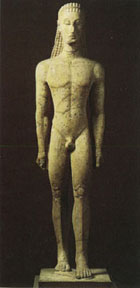.
Ancient Greece

Cycladic Figure |

Greece Map, 440 BCE |
Greece
is located on a peninsula in and around the Aegean Sea, a section of the Mediterranean
which is dotted with numerous islands. The history of the foundation of the
Greek civilization is a complex story. The first people to populate the Agean
shores were sailors who travelled from Asia Minor beginning around 3000 BCE
(corresponding with the beginnings of Egyptian, Mesopotamian, and Oriental
civilizations). They kept coming for over 1000 years, as Greece welcomed them
with many months of sunshine. They called themselves the Shore People, and
the most famous of these tribes are now known to us as the Cycladics (populating
the island of Cyclades), whose abstract figurines are associated with the
foundations of later Greek art. North of Greece was the continent of Europe,
which was at this time sparsely populated by Germanic tribes. Living in a
less hospitable and cold environment, they continued the practices of earlier
hunting cultures, banding together like packs of wolves to survive. When they
made their way through the mountain passes of Greece, it was their first site
of a civilized city. The Germanic tribes were savage fighters and had horses
which the Asians had never seen before. When the tribesmen conquered, they
kept the Asian sailors to be their farmers and craftsmen, taught them their
language, and eventually took them into their family of tribes. It was several
centuries later that the civilization which we call Ancient Greece had its
beginnings. Eventually, the glory of Greece would spread across the Mediterranean
to the coast of north Africa (including Egypt), as well as southern Italy. The civilization of ancient Greece spans from about 1200 B.C.E (when Mycenaean
civilization perished) to 323 B.C (which marks the death of Alexander the
Great).
The
Acropolis and Parthenon

Reconstruction Model of The Acropolis, Athens |

The Parthenon
|

Elgin Marbles
(Removed from Parthenon)
|

Statue ofAthena
(Roman Reconstruction) |

Porch of Maidens
Erechtheum, Acropolis
|
(Note:
Essays on the artwork will be added at a later date)
Evolution of Architectural Styles

Doric Columns from the Parthenon
|

Ionic Style
|

Corinthian Capital
|
Evolution
of Sculptural Styles

Apollo
Geometric Period
|

Kouros (Youth)
Early Archaic
|

Kouros
Late Archaic
|

Spear Carrier
Classical
|
The evolution of Greek sculpture
begins with the Archaic period, progressing to the Classical and Hellenistic
periods. Though each of these have early, middle and late subperiods, the
most important aspects of each is that the Archaic is more rigid in
stance due to equal weight on both feet. The anatomy is abstracted (or simplified),
and there is no emotion apparent (eyes generally stare forward). During the Classical period, there is an increased interest in accurate human
anatomy, the pose becomes more natural and relaxed as the weight is shifted
from one leg to the other, and there is a sense of idealism (figures of this
period are of their ideal physical types). Emotion is also restrained in the
classical style.

Peplos Kore
Archaic (530 BCE)
|

Aphrodite of Melos
Classical
|

Wounded Amazon
Late Classical
|

Nike of Samothrace
Hellenistic
|
Hellenistic
Sculpture

Prometheus
|

Lacaoon Group
|

Old Market Woman
|
During the Hellenistic period,
anatomy continues to be well observed, and there is an increased interest
in movement or action of the figures. In addition, there is less idealism
and more stress on expression of emotions. The images of Prometheus and Lacaoon,
for example, are both expressive of pain and anxious tension. Also, the figure
of an old woman, at right, would not have been expressed during the Classical
period, for she lacks all idealism. An exception to the lack of idealism expressed
in the Hellenistic period is the famous Nike of Samothrace (also known as
the Winged Victory, above).
Greek
Ceramic Painting

Geometric Period
|

Early Archaic
|

Classical |

Dionysus and Revelors
Archaic
|

Offering Ceremony
Classical
|

Herakles
Archaic |

Herakles
Classical
|
Next: Ancient Rome
|